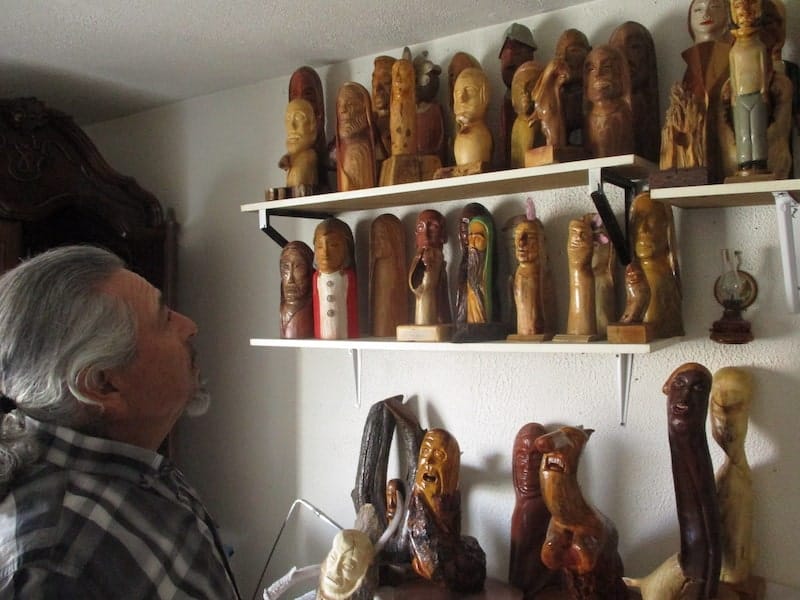
Sculptor finds personality in the woods he carves.
He hecho un mundo
Forests of characters populate shelves and tabletops in Herman Herrera’s home. Faces and figures carved from both raw wood and dimensional lumber peer out and suggest a range of personalities and stories, wearing blissful smiles, drawn brows, or stoic gazes. One long face, sprouting a huge nose formed from a natural branching of the wood, looks like it’s in mid-sneeze.
Herrera, a self-taught artist, grew up in New Mexico and traces his interest in wood carving to his grandfather and great uncles who built cabinets as a hobby. They’d take logs to be milled into boards and rub them with wood ash to give them an antique look.
Herrera took his woodworking in a more creative direction. He likes to use branches, roots or burls with character, and allow the natural shape of the wood to guide the pieces he carves.
“You want to work with what is there,” he said, holding out a branch and pointing out knots and curves he would try to incorporate into a piece. In a carving he calls “Man Without a Cross,” the swoops and intersections of the natural wood are still visible in the Christ figure with outstretched arms. There’s no cross; Herrera prefers the less literal representation.
“I didn’t want it to be just another crucifix,” he said.
Herrera has lived in Moab for the past 20 years but still feels a strong connection to his hometown.
“It feels strange, but the most amazing thing is I still miss New Mexico,” he said. “Even the wood seems to be better there.”

He displayed a sculpture he’s making from a twisting piece of wood his brother brought him from New Mexico. It’s a fantastical creature with a gnarled tail and humanoid face—something like an eerie mermaid crossed with a seahorse.
New Mexico is not only Herrera’s childhood home but also where many of his family members still live, including his three adult daughters, Misty, Joni and Heather. But Moab is home for him too — he’s established a sense of community and is proud of the home he shares with his wife and his son, Tyler.
Herrera carves at a desk outside his house, equipped with a vise and drawers full of cutting and carving tools. He’s working on outfitting a small outbuilding as an indoor woodshop. His pieces are for sale at the Trading Post in Moab on south Highway 191, and this past winter, he exhibited his work at the Moab Arts and Recreation Center.
At the exhibit opening, he read an excerpt from a book he’s writing: the working title is Ángel Mío. Herrera’s first book, El Coyote Pinto, is a lyrical memoir of his early years in New Mexico and is available through online booksellers and at stores throughout Moab. He’s 13 chapters into his second book, which will also explore his ancestry, as well as introduce people he’s met over the years and what they’ve shared with him. He’s not sure when he’ll be done writing it.
When he’s not writing or carving (or working his full-time job at the Community Recycle Center), Herrera hosts a radio show, Entre Las Piedras, playing a variety of music on local station KCYN. He DJ’d on the radio for nine years in New Mexico, and for another 12 at Moab’s community radio station, KZMU. He’s a musician himself: he sings, plays guitar, and writes songs. He’s often asked to play at family weddings and funerals, and he’s submitted some of his compositions to a local musician who plans to bring them to Nashville. He said he writes mostly about love and betrayal — classic country music themes.
“Love is easy, and betrayal is even easier!” he quipped.

While Herrera misses New Mexico, he also loves Moab. He remembers an uncle who would say “Han hecho un mundo,” or, “They’ve created a world,” to describe people who have built their communities and surroundings to facilitate a content and productive life. That’s how Herrera feels about his home in Moab — he’s surrounded himself with the tools and venues for his creative outlets. Lately he’s been especially inspired to carve.
“I just want to see what my next creation will look like,” he said.
If you’re not local to Moab and are interested in Herrera’s sculptures, books or music, you can contact him at emiomine@gmail.com or 435-280-7639.



